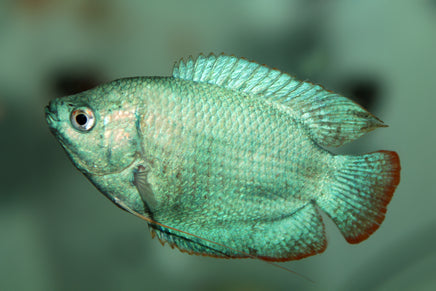
Males are blue and can reach 3.5 inches while females are grey and only reach 3 inches. When males are in the presence of a female they develop a purple chest and flare up their dorsal fins. What distinguishes the Powder Blue Dwarf Gourami from the Dwarf Gourami is that the former has no red stripes. They have a labyrinth organ that functions like a lung and allows them to breathe atmospheric air, this works as a survival mechanism for when they are in drought affected areas or polluted waters. To keep these fish in captivity, water temperature should range from 72ºF to 82ºF and water pH should be between 6.0 and 8.0. The tank should have lots of plants and hiding places and it should be placed far from noisy areas. Powder Blue Dwarf Gouramis can be kept in community aquariums, however, larger and aggressive tankmates should be avoided. Males of this species shouldn’t be kept together and a pair of male/female isn’t recommended because the male may become aggressive towards the female, a group of several females to a male is recommended.
Diet - This species is omnivorous. In the wild it feeds on invertebrates and algae. In captivity it can be fed with dried, live or frozen foods
Sexing - Males are more colorful, larger and have extended dorsal and anal fins.
Breeding - To breed this species in captivity, the breeding tank should be of 10 or 20 gallons and water temperature should be between 80ºF and 84ºF. It is very important for the tank to be heavily planted with fine leaved plants. The male starts by building the bubble nest, this species of Gouramis includes leaves on their nest which is quite unusual, then he will try to get a female’s attention. The female will release the eggs and the male will release his sperm fertilizing the eggs, then the male will gather them in the bubble nest and guard them, at this time the female should be removed since the male may attack her. Eggs take 1 to 2 days to hatch and once the fry become free swimming the male will stop guarding and may even try to eat them.
